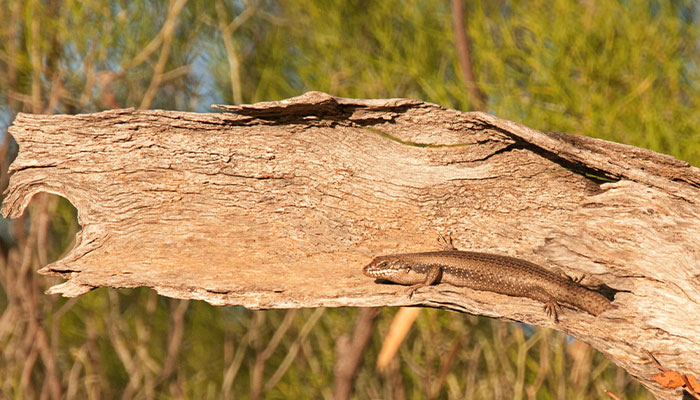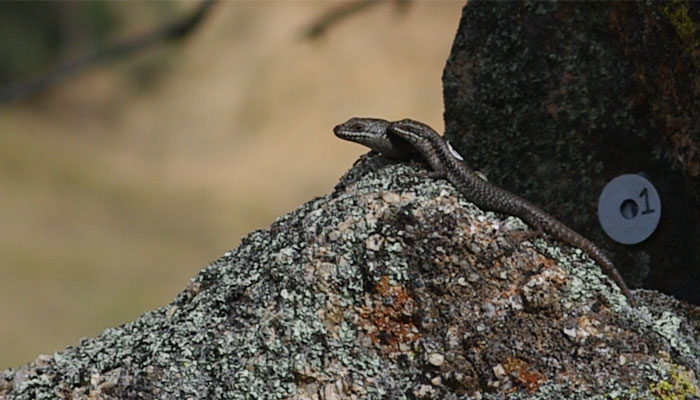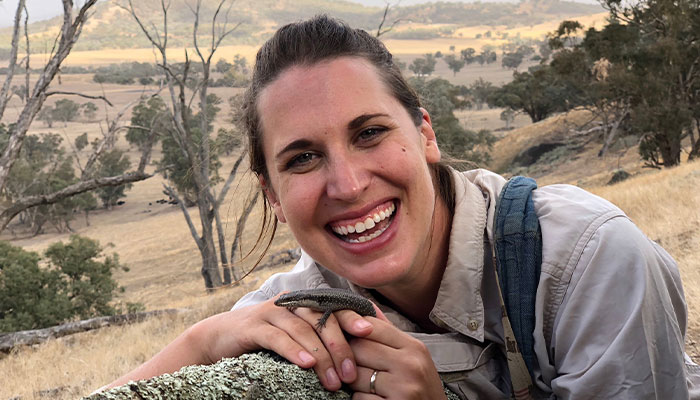Female Australian tree skinks can successfully reproduce without access to males by storing sperm from previous mates for more than a year, according to a new study recording the first known example of sperm-storage in monogamous family-living reptiles.
Researchers studying the behaviour of Australian tree skinks in Macquarie University's Whiting Laboratory got a big surprise when some of their segregated female lizards produced offspring more than a year after they had been captured.
"We knew some of the skinks were gravid [pregnant] the first year when we collected them," says Dr Julia Riley, lead author of the research now published in the Journal of Heredity.
Some of the female skinks gave birth soon after capture, and through genetic analysis, Riley found that, within each litter, the offspring were full siblings.
Our study suggests that female sperm storage, potentially from outside social partners, offers the real possibility of benefits.
"Then, despite keeping them apart from their offspring and from other males, to our surprise, we found that three of our female skinks were gravid a year later," she says.
The researchers monitored the births, but there were more surprises in store when they ran genetic tests on the newborn skinks: offspring from the second litters had different fathers to those born shortly after capture.
Tree skink 'swingers' might bring survivalist genes
Riley says that further testing showed that the litters resulting from sperm stored by these shrewd female skinks were more heterozygous (genetically different) than those produced from recent matings.

Home bodies: Australian tree skinks rarely stray far from their birthplace.
"Our study suggests that female sperm storage, potentially from outside social partners, offers the real possibility of benefits - like increasing genetic compatibility of mates and reducing the impacts of inbreeding," she says.
Although Australian tree Skinks (Egernia striolata) are widespread across central and eastern Australia, they rarely stray far from their birthplace, so any behaviours that improve genetic diversity are an advantage, she says.
While reptiles play a vital role in ecosystems, they are in peril all over the world.
Tree skinks reach maturity at around two years, by which time they are around 10-12 cm in length. They live in territorial, multi-generational family groups of two to ten skinks, mainly beneath tree bark, or in hollow logs and rock crevices, and usually stay with the same mate for many years.
"The famously-social Egernia-group of skinks includes well-known Australian species like blue-tongue skinks, shinglebacks, gidgee and tree skinks," Riley says.

Pair bonds: Tree skinks usually stay with the same mate for many years.
She spent several months observing hundreds of tree skinks in the wild – in this case, a rocky outcrop in a cow paddock outside Albury in southern NSW.
"It was fascinating to spend so much time studying these little skinks, documenting their curious social life," Riley says, adding that she often watched them through binoculars, as skinks are very smart animals who quickly learned to evade being captured and tagged.
"Many people think of reptiles as slithery, frightening, and alien creatures, and don't think of them as living in social groups or forming lifelong pair bonds," she says.
"But while reptiles play a vital role in ecosystems, they are in peril all over the world, and learning about their behaviour can help us understand their population dynamics and how we can reduce our impact on them."
Part of a bigger picture
Riley says that the study suggests that female skinks' sperm-storing superpower could be keeping the skink gene-pool healthy by introducing the occasional outside male mate into an ostensibly monogamous arrangement.

In the field: Dr Julia Riley spent several months observing hundreds of tree skinks in the wild, in a rocky outcrop outside Albury.
"If this is the case, females may well have the upper hand in a world often dominated by sexual conflict," she says.
Riley's research was part of her PhD supervised by Macquarie University behavioural ecologist Professor Martin Whiting, who specialises in animal social behaviour and cognition.
Professor Whiting, who heads the Whiting Laboratory, says the research fits into a bigger picture that's emerging about animal behaviour.
Our laboratory is asking big questions about the early evolution of family living – a common behaviour in birds and mammals, but rare in reptiles.
"Over the past 20 years or so, we have found that females have a lot more control over reproduction within species than we previously believed," he says.
Past narratives of sexual selection focused on competition between males to ensure their own reproductive success – but in many species, females make significant reproductive choices, he adds.
"Julia's research shows that a skink we thought to be monogamous, can choose to use year-old sperm from a different male to its long-term partner to fertilise its eggs," he says.
"This gives her a better chance that more of her offspring will survive, by ensuring genetic diversity – or heterozygosity.
"Our laboratory is asking big questions about the early evolution of family living – a common behaviour in birds and mammals, but rare in reptiles."
Unlike most lizard species worldwide, family living is common in the many species of Egernia lizards native to Australia, he says – and this research raises interesting questions about how females mate outside the family group to broaden genetic diversity.
Martin Whiting is a Professor in the Department of Biological Sciences






